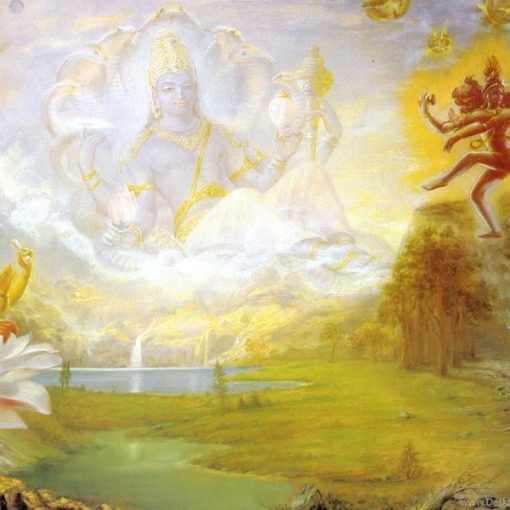The Cosmic Drama Unfolds: Creation, Sustenance, and Liberation
In the sacred forest of Naimisharanya, the atmosphere was heavy with expectation. The revered sages, led by Saunaka Rishi, sat in a circle, their faces lit with curiosity and reverence. The air was electric. They had just asked profound questions, questions that could unlock the mysteries of creation, the nature of the soul, and the highest purpose of human life. At the center stood Suta Goswami, the great disciple of Srila Sukadeva Goswami, holding in his heart the entirety of the Bhagavatam’s divine wisdom. The sages’ gazes were fixed on him, their breaths held, waiting for him to speak.
With a sense of deep humility, Suta Goswami offered obeisances to his spiritual master, Srila Sukadeva Goswami, the son of Vyasa, whose heart was as pure as crystal and whose mind was free from the illusions of this world. Even as a young boy, Sukadeva had forsaken material life, unaffected by the temptations that bind ordinary men. He had walked the forests naked, liberated from birth, unattached to worldly possessions or rituals.
The tension in the air was palpable as Suta Goswami began his recitation, his voice calm but filled with a sense of gravity that made the entire assembly lean in. They knew this was not just any discussion—this was the answer to life’s most crucial questions.
The Supreme Personality and the Material World’s Genesis
“The Supreme Lord, Vāsudeva, untouched by material energy, began the process of creation not for His own need but for the welfare of the living entities,” Suta Goswami explained. The Lord, by His inconceivable energy, orchestrated the manifestation of the cosmos. First came the elements—earth, water, fire, air, and ether—and from these came the gross material world. But the Lord, like an artist who remains separate from his canvas, remained transcendent, never entangled in the web of creation.
The audience of sages listened in awe. Suta Goswami described how the Supreme Being, by His will, entered His creation as Paramātmā, the Supersoul, residing in every heart and atom, yet never losing His supreme position. The Lord, he explained, is like fire within wood: although present everywhere, He is not diminished by His presence in the material elements.
The sages exchanged glances, their minds blown by the sheer scale of the divine drama unfolding before them. The Lord’s creation was not just a mechanical process; it was imbued with love, wisdom, and purpose. The Lord had given every soul the opportunity to break free from material bondage through devotion.
The Three Modes of Nature: Bondage or Freedom
Suta Goswami then turned to the topic of the three modes of material nature—goodness (sattva), passion (rajas), and ignorance (tamas). With a voice that grew more intense, he described how these modes act like invisible chains that bind the soul. Under ignorance, one lives in darkness, unaware of the higher truth, consumed by delusion. Passion drives men toward endless desires, never satisfied, always chasing but never catching true happiness. Goodness, though the highest mode, still binds one to the material world, albeit with clarity and peace.
“But,” Suta Goswami paused, his eyes sweeping the audience, “even goodness is not enough.” The sages leaned forward. “To attain true liberation, one must transcend these modes through bhakti—pure devotional service.”
The weight of his words hung in the air. Devotion to the Supreme Lord, Suta Goswami explained, is the key to breaking free from the modes and attaining the eternal realm, where the soul is free to serve the Lord in bliss.
Brahma, Vishnu, Shiva: The Cosmic Trinity
In a stunning revelation, Suta Goswami expounded on the cosmic roles of Brahma, Vishnu, and Shiva. The three great personalities who govern creation, maintenance, and destruction are not independent; they work under the direction of the Supreme Lord. Brahma, born from the lotus sprouting from Lord Vishnu’s navel, creates the universe. Shiva, in his destructive form, eventually brings it to an end. But Vishnu, in the mode of goodness, sustains the world and, most importantly, offers the path to liberation.
“Vishnu,” Suta Goswami continued with a dramatic flair, “is the only one who can grant moksha—freedom from the cycle of birth and death.” The demigods may grant material boons, but only Vishnu can offer eternal life.
The sages nodded, fully absorbed. They understood that this was not mere mythology but a profound truth—the Lord’s grace is the only means by which a soul can be saved.
Bhakti: The Sword That Cuts Through Karma
Suddenly, Suta Goswami’s tone shifted. The conversation moved to bhakti, the highest form of devotion, and the ultimate goal of human life. His words rang with urgency. “The supreme occupation for all mankind,” he declared, “is that which leads to unmotivated, uninterrupted devotion to the Lord.”
Here was the crux of his message: without pure devotion, everything else is meaningless. Acts of charity, piety, even austerities and sacrifices, are worthless if they do not awaken love for Krishna. He likened devotion to a sword—one that cuts through the tangled knots of karma, freeing the soul from the bondage of material existence.
The imagery was powerful. The sages could see the metaphorical knots—lifetimes of desires and actions that bound the soul—and they could feel the sharpness of bhakti slicing through them. There was no doubt left in their minds: devotion was not a passive act but an active, transformative force.
Transcending the Material Modes: The Path of the Liberated
As Suta Goswami continued, he painted a vivid picture of the liberated soul. “Once devotion is established in the heart,” he said, “the modes of passion and ignorance dissolve, leaving the soul free to experience its true, divine nature.” In this state, the soul no longer hankers after material pleasures. Instead, it rejoices in the pure bliss of serving the Supreme Lord.
The sages could almost taste that transcendental ecstasy. They saw before them the path to liberation—one of continuous, uninterrupted love for Krishna. It was not an abstract idea but a living, breathing reality that could be achieved through steadfast devotion.
The Role of Constant Remembrance
In his final message, Suta Goswami emphasized the power of constantly remembering the Lord. “With one-pointed attention,” he said, “one must hear about, glorify, and meditate upon Krishna.” His voice echoed through the sacred grove as he declared that Krishna’s name, when chanted with sincerity, enters the heart like a cleansing flame, burning away all impurities.
This was the key: constant remembrance of Krishna would lead to perfection. It was not enough to merely know about the Lord. One had to immerse oneself in His name, His pastimes, and His teachings.
The sages sat in silence, their hearts filled with awe. They realized that this was not just a philosophy but a way of life. Suta Goswami had given them the blueprint for attaining the highest goal of life—eternal union with the Supreme Lord.
The Dawn of a New Spiritual Age
As Suta Goswami concluded his discourse, the forest of Naimisharanya seemed to come alive with divine energy. The sages were transformed, ready to take the message of bhakti into their hearts and into the world. They had been given the greatest gift: the knowledge that devotion to Krishna is the only path to eternal happiness.
In this chapter, the cosmic puzzle of creation, maintenance, and destruction was laid bare, but more importantly, the solution to the soul’s eternal quest was revealed. Bhakti, unmotivated and uninterrupted, is the supreme occupation, and through it, every soul can transcend the material world and enter into the loving embrace of Krishna.
The journey toward liberation had begun for the sages, and now it begins for you.





